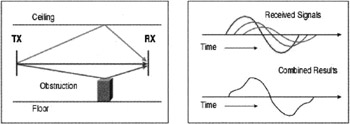Antenna Usage
|
| < Day Day Up > |
|
Antennae are generally classified by the directivity of the antenna. "Directivity" refers to the ability of an antenna to focus energy in a particular direction when transmitting. Conversely, it also has the ability to better absorb energy from a particular direction when receiving. The radio coverage of the wireless LAN can be maximized with the selection of an appropriate antenna. Antennae are available with omni-directional or directional radiation patterns, and with various gain ratings.
Restrictions
To understand how antennae work within a WLAN environment, the WLAN designer must understand the limitations due to indoor propagation. Any radio transmission in an indoor office environment is subject to interference, including multipath interference, and thus excess signal loss.
Multipath interference occurs when an RF signal has more than one path between a receiver and a transmitter. This occurs in sites that have a large amount of metallic or other RF reflective surfaces. Just as light and sound bounce off of objects, so does RF.
Multipath interference can cause the RF energy of an antenna to be very high, but the data would be unrecoverable. Changing the antenna type and location can eliminate multipath interference.
| Note | Perhaps the best way to explain multipath is to relate it to something that commonly occurs when listening to an FM or AM radio in a car. As the driver pulls up to a stop, he or she may notice static on the radio. But as the car moves forward a few inches or feet, the station begins to come in more clearly. This occurs because by rolling the car forward a bit, the car antenna's position changes only slightly, but just enough so that it is out of the zone where the multiple signals converge. |
A radio that could link up over a range of several hundred feet in "free space," can only achieve 50–150 feet or so indoors, because the propagation path is rarely direct when the signal must travel via waves that are contained within a building. This is because most of the time the signal must pass through or bounce off walls and other objects. Additionally, when using 802.11b (or g) technology that operates in the 2.4 GHz frequency band, you run into signal absorption by water that exists as moisture in the air, and in water-bearing foods (that's why microwaves use this frequency). Human bodies are the equivalent to "water bearing food," meaning that there will be a difference in range as people move about an area during their work day.
However, while changes in humidity can affect signal integrity, and in an outdoor environment rain can produce a measurable effect on signal strength, snow and hail are usually not a problem. Here's a bit of food for thought if deploying an antenna out-of-doors: rain falling at a rate of 6 inches per hour can cause additional signal losses of about 0.02 dB per .6 miles (1 kilometer) between links. Thus, unless you try to connect very long links, rain is not really much of an issue—it is just another factor that needs to be accounted for when it comes to potential interference.

Figure 19.1: Multiple signals combine in the RX antenna and receiver to cause distortion of the signal. There can be more than one path that RF takes when going from a TX (transmit power) to a RX (receiver sensitivity) antenna. Graphic courtesy of Cisco Systems.
For the most part, many of the restrictions in indoor environments do not exist for outdoor sites. In outdoor or free space, the propagation is limited by the standard free space path loss. Normally, the loss in free space is equal to range squared, but indoors, the loss exponent is more like the 4th power—when a sheetrock wall is penetrated, there is approximately 6 decibles (dB) of loss, whereas a concrete wall causes around a 20 dB loss. Once the direct path experiences too great a loss, the alternate multipath rays will carry the signal. Thus, it is hard to know with certainty what path the signal will follow at any given time.
| Note | An increase in coverage within an antenna's beam width is called "antenna gain," whereas a decrease in coverage is referred to as a "loss." Both are measured in decibels (dB). |
There are two types of signal fade caused by multipath propagation. One is caused by signals bouncing off of walls to get to the RF receiver. The other is due to the summation of local signal paths, which can lead to cancellation of the signal.
Whatever the cause, a situation often occurs where there is a great discrepancy between predicted range and actual range. This can result in difficulty determining a WLAN's cell size. If you have propagation in a long hallway, the loss can be small, but a multi-path signal can still arrive with almost the same level and out of phase, effectively canceling a portion of the signal. Even small movements can substantially affect reception.
| Note | A radiated signal is comprised of waves that oscillate simultaneously during transmission. Waves that move within the same oscillation frequency and thus reinforce each other are said to be "in phase." When waves are in phase and encounter no obstructions, the received signal is strong and clear. However, when waves encounter an obstruction (metal, wall, trees, etc.), they can be reflected, bent or absorbed causing the waves to reach the target with different path lengths and at different times. This phenomenon is referred to as "multipathing," and results in the fading or nullification of the signal at the receiving end. The longer the path of the transmitted waves, the more likely it is that they will suffer multipath interference. |
|
| < Day Day Up > |
|
EAN: 2147483647
Pages: 273